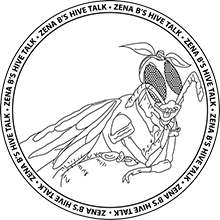Hive Talk - October 2021
Hive Talk October 2021

October 2021- Hive Talk
I bet most of you are wondering about what we do with our bees from Spring until Fall.
After a long winter I go out to the hives to see if they survived by doing an audible check on the hives. What is that you ask? I take my stethoscope out to the apiary. I listen through the hive entrance, if I don’t hear anything I give it a light kick with my boot and that usually gets a response! (They are a little louder, and a guard bee will peek out the hole)
This spring I had to dig 4’ of snow from around the hives so that the girls could safely fly, defecate, and return without any trouble. That’s after a hefty trek with my snowshoes to their location with a snow shovel. Later on in the month when the weather is more stable I will insert miticide strips (Apivar) to control the Varroa Mite, and start feeding 1:1 sugar syrup, with a delicious pollen patty.
As the weather becomes warmer and doesn’t fall below freezing, I will remove the main windbreak from the hives, but leave on the ’wraps’ for a few weeks until the warm weather settles in.
After waiting for 6 weeks with the miticide strips in the hives I can remove them, but can’t put any honey supers on for another two weeks until the hive is free of any medicine. Next I’ll remove all of the winter wraps, open the hives to inspect their condition, clean up any burr comb on the frames, and check the size of the colony. At this point I will know whether or not to anticipate a ‘split’, or join two colonies together, and check the health of the queens. By this time they should be in full egg laying mode.
Once that is done, we install a queen excluder between the brood boxes, and set on a honey super. We then let the bees do their thing for a couple of weeks, or a month, and check the queen’s performance again to see if she needs to be replaced. At this point the bees may make that decision for me by indicating the presence of ‘queen cells’. This will tell me if they are concerned about the health of their queen, or are ready to leave and find a new home as they did this year. If they do I will offer them another hive setup and split them before this happens. I will need a new queen, or let the queenless colony make their own.
During the summer we did 3 extractions. We extracted more frequently this year due to the hot dry weather. The type of nectar in this area is Canola, and if left too long in the honeycombs it will crystallize and we will not be able to extract the honey out of the honeycombs.
Throughout the summer I inspect the hives every two weeks and try to recognize abnormal behaviour which would then prompt me to open them up to take a peek. If everything is happy, and busy, I normally extend my inspections to once a month (ish).
Fall rolls around, that is when I take the honey supers off (our honey), and let the bees store food in the hive for their winter supply. I will also give them 2:1 sugar syrup to help with that as most of the flowering plants have finished their season.
Miticide application will begin again to help them through the winter as the mites will weaken the hive to the point of collapse. This year I used a product called Oxalic Acid vapour in the hives. It is a good practise to use two different miticides to prevent the mites from becoming immune.
Colder weather rolls around by the end of October, and the hives will be arranged in a square and wrapped with insulation, and a wind tarp. At this point they are on their own as they have selected all of the television shows, games, and food stores to last them for the next 5-6 months of winter.
Kidding aside, that is not what the bees do during the dark days of winter. What they do is to keep the queen and colony warm and fed until they hear me knocking at their door in the spring.
Honey bees need help to survive as they are not indigenous to North America. I like to compare their wellbeing to managing livestock, but in a smaller application. They need to be protected, medicated, and fed so that we can reap their bountiful byproduct …...honey!
Hats off to the residents of Burstall, and surrounding area, for having such beautiful gardens this year. Both the ‘girls’ and the wild bees and insects all appreciate your efforts. Don’t be too fussy cleaning up the leaves in your yard, as the insects use the fallen leaves to insulate themselves from the cold weather ahead.
